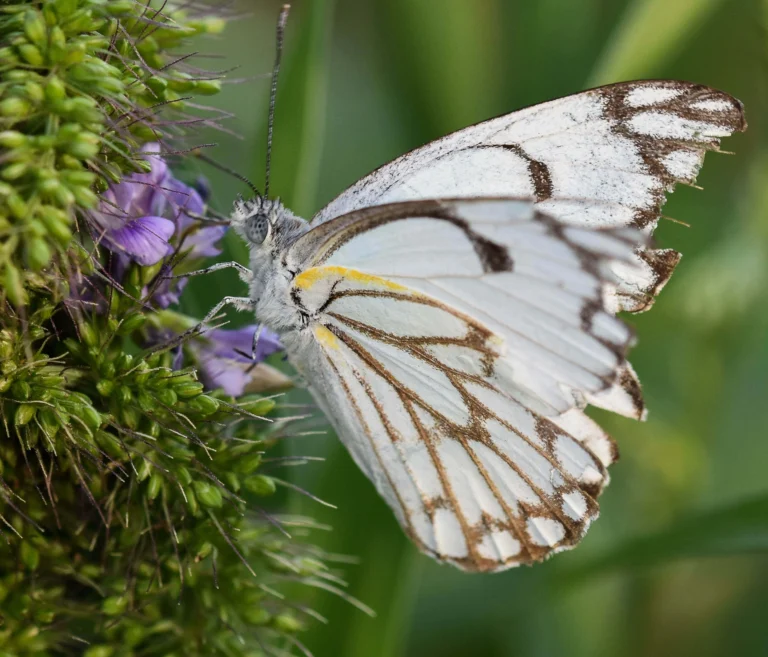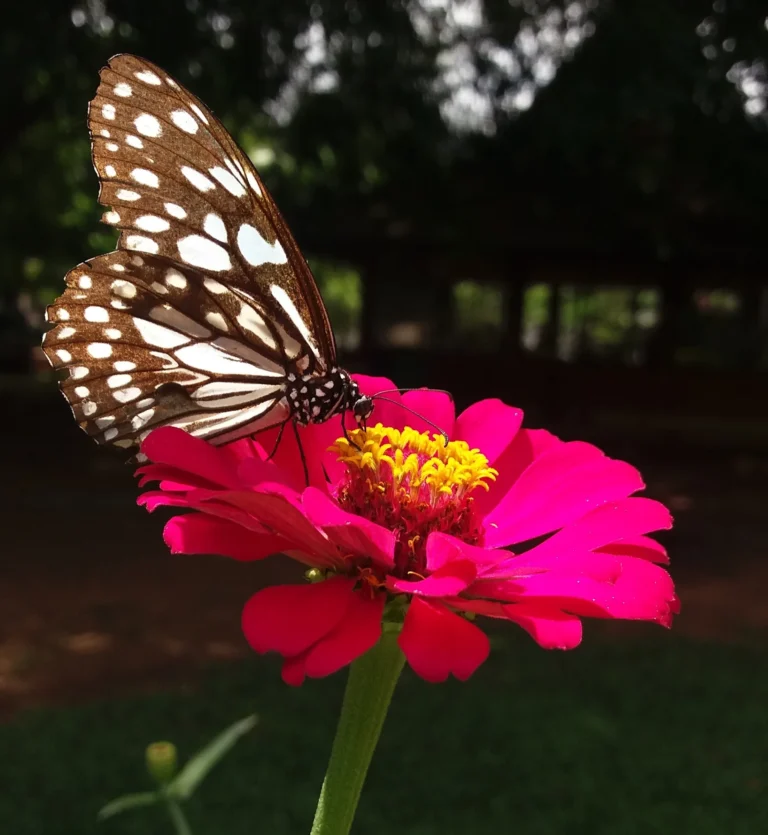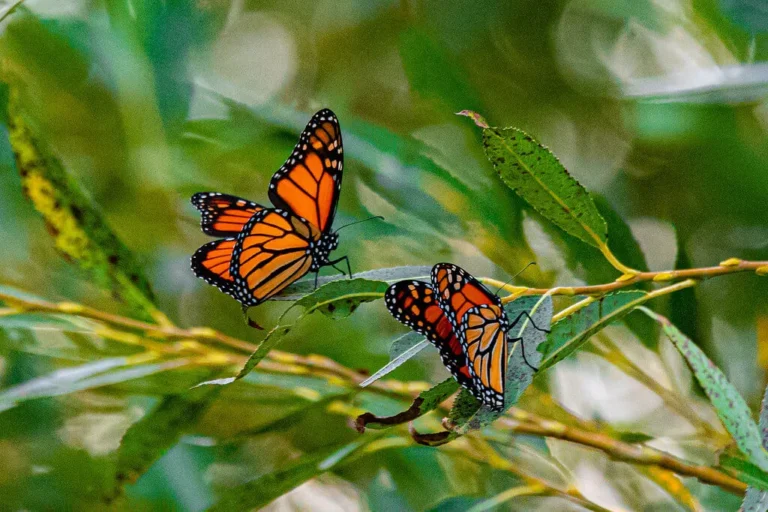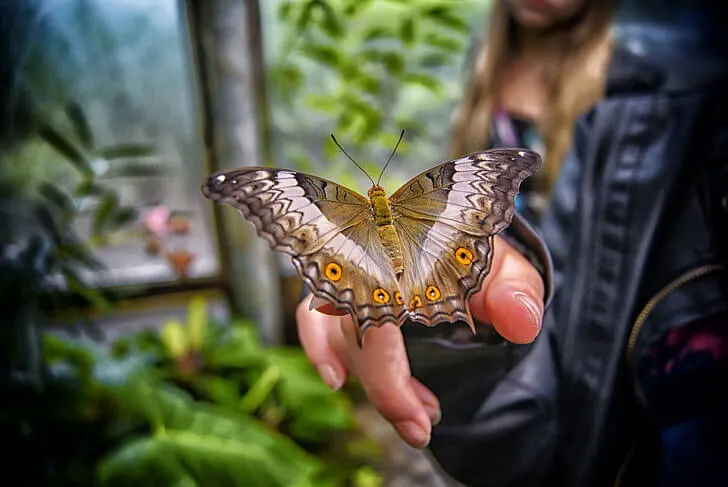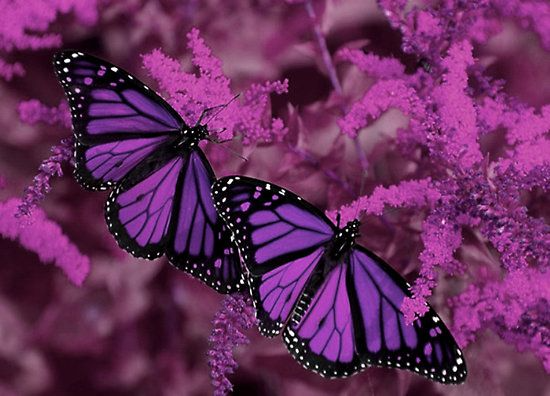Do Butterflies Eat Meat? Delving into Their Diet Mysteries
Butterflies, known mainly for sipping nectar, sometimes seek out nutrients from dead animals. They don’t eat meat like predators; instead, they’re drawn to the salty liquids in these animals for essential nutrients, especially sodium. Besides nectar, their diet can also include tree sap, overripe fruits, and even dung. Such varied diets showcase their adaptability in nature, making them more than just colorful insects fluttering around flowers.
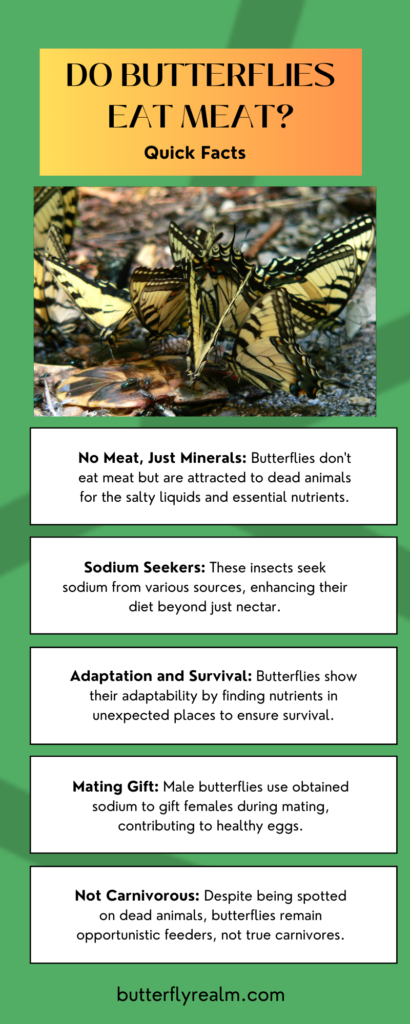
Table of Contents
Introduction:
Have you ever paused to watch a butterfly gracefully move from one flower to another on a bright day? It’s a common sight that suggests they’re sipping on some sweet nectar. That’s their main meal, isn’t it?
Yet, as with many wonders of our world, there’s often more beneath the surface. Today, we’ll dive into a less-discussed aspect of butterfly behavior: their dietary habits. Specifically, we’ll address an intriguing question: Do butterflies eat meat?
Join us as we uncover some unexpected truths about these beautiful beings.
Background: What Do Butterflies Typically Eat?
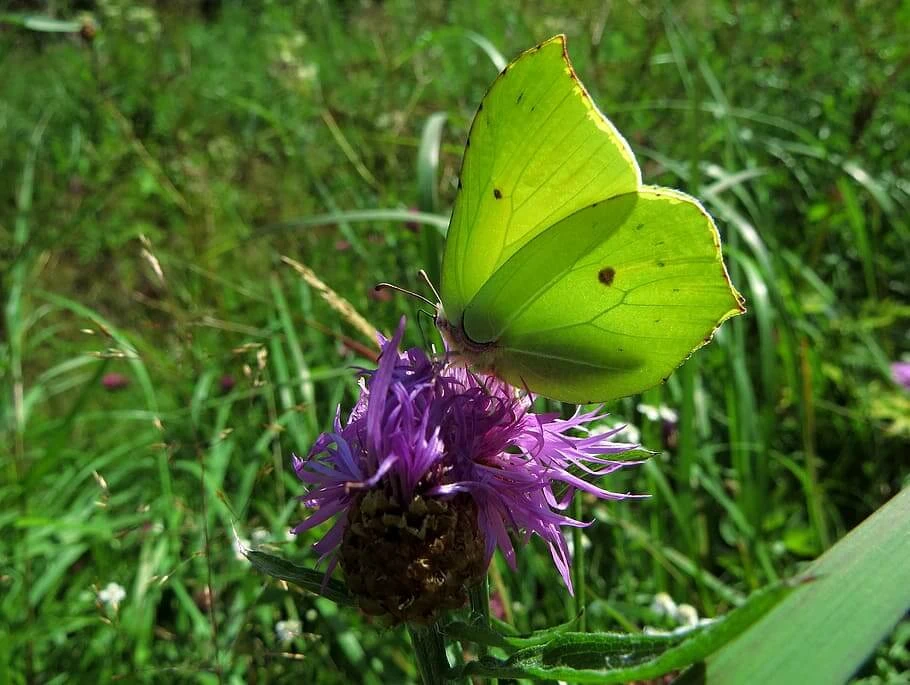
When the topic of a butterfly’s diet comes up, many immediately think of sweet nectar. And that’s not wrong! During their short lives, many adult butterflies mainly drink nectar from flowers.
This sugary liquid gives them the energy they need to fly, mate, and go about their daily lives.
But what about when they’re still caterpillars? That’s a different story. Caterpillars are pretty hungry creatures.
They munch on leaves and other plant parts to grow bigger and prepare for their big change into a butterfly. Some might even say they’re eating machines!
Now, nectar and leaves are all well and good, but nature is full of diversity. Just like we humans don’t only eat one type of food, butterflies also seek variety. They’ve been spotted enjoying tree sap, overripe fruit, and even – wait for it – dung! Yes, you read that right.
But what about meat? Do these gentle creatures ever consume it? Let’s take a closer look.
The Fascinating Truth: Do Butterflies Eat Meat?
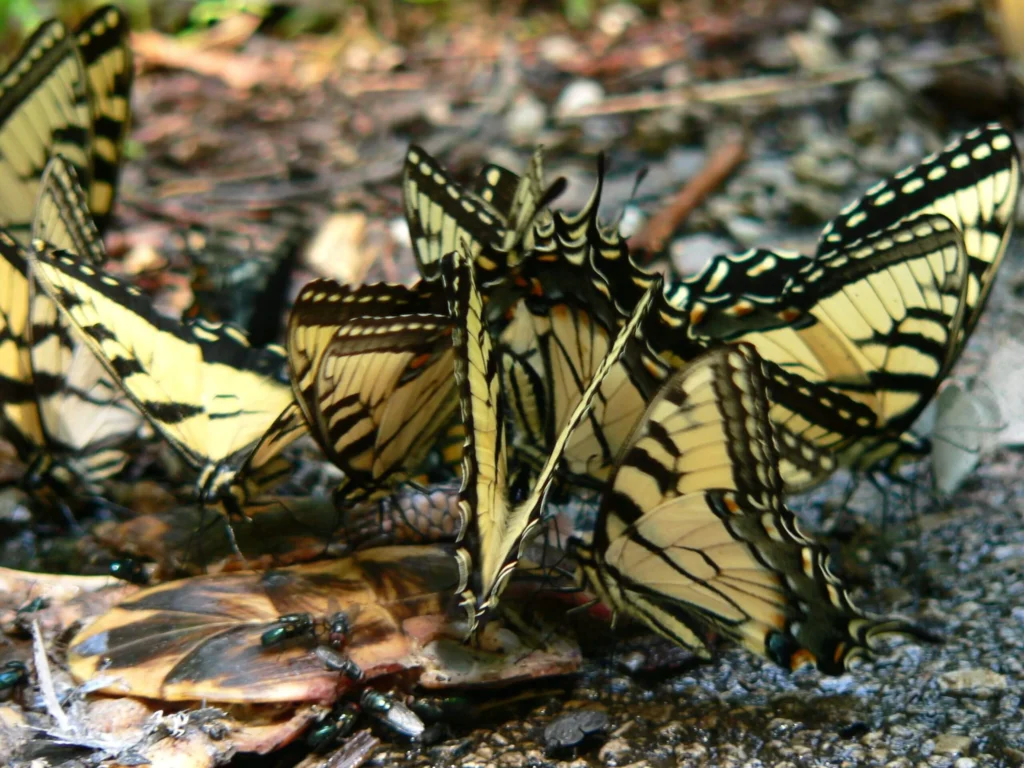
When we think of meat-eaters, butterflies surely aren’t the first to come to mind. Lions? Yes. Eagles? Absolutely. But butterflies? It sounds like a story from a fairy tale. Yet, there are times when butterflies have been spotted on dead animals or fish. It’s not a common sight, but it’s a real one.
Why would a butterfly be interested in meat? They’re not biting chunks off like a predator. Instead, they’re after the salty liquids they can find on these carcasses.
Just like we might crave a salty snack now and then, butterflies too seek out salt and other essential nutrients. They use their long straw-like tongue, called a proboscis, to sip these liquids.
While it’s a bit unusual and might not match the delicate image we have of butterflies, this behavior shows how adaptable and resourceful they can be. Life isn’t always flowers and sunshine, and butterflies, like all creatures, do what they need to survive.
Nutritional Value: What Do Butterflies Gain from Eating Meat?
It might be surprising to think of a butterfly seeking nutrients from meat. But when we break it down, it starts to make a lot more sense. Everything alive needs a mix of nutrients to thrive, and butterflies are no different.
One of the big things butterflies are after is salt, especially sodium. In the wild, sodium can be hard to come by. While flowers offer nectar, a sweet treat full of energy, they don’t always provide enough of those much-needed salts.

Male butterflies, in particular, have a unique reason to chase after sodium. They gift it to females during mating, which helps ensure healthy eggs. So, when a butterfly is spotted on a carcass, it’s not so much about the “meat” as it is about the rich source of sodium and other minerals.
But it’s not just salt they’re after. These meaty pit stops also provide amino acids, which are the building blocks of life. Amino acids support butterfly health and can even enhance their ability to reproduce.
In the grand scheme, these butterflies aren’t turning carnivorous. They’re simply taking advantage of a nutrient-rich opportunity when it presents itself.
Other Unusual Butterfly Diets

The world of butterflies is filled with more surprises than just their occasional interest in meat. These colorful creatures have some other quirky eating habits that are sure to raise an eyebrow or two.
For starters, have you ever sweated on a hot day and felt a butterfly come a bit too close for comfort? It’s not your imagination! Some butterflies are drawn to human sweat.
Why? Our sweat is salty, and as we’ve learned, butterflies have a thing for salt. They can extract minerals from sweat, much like they would from a carcass, but perhaps a bit more pleasantly!
And that’s not the end of it. Some butterflies in the wild have been observed drinking tears from turtles. It’s a behavior called “tear-feeding” or “lachryphagy.” Just imagine, a butterfly gently landing near a turtle’s eye and sipping its tears. It’s as if nature has its own version of tearjerkers.
These behaviors, as odd as they might seem, highlight how versatile and adaptable butterflies can be. They’re not just about the nectar. They take the phrase “make the most of every opportunity” to a whole new level!
Then there are moth species, like the Luna Moth, that have their own set of fascinating dietary quirks.
Ecological Implications
Nature is like a giant jigsaw puzzle where every piece, no matter how small or seemingly insignificant, plays a vital role. Butterflies, with their unique diets and behaviors, are no exception.
When butterflies seek out meat or unusual dietary sources, they aren’t just meeting their own needs; they’re playing a role in the bigger picture of our ecosystem. Dead animals, for instance, need to break down and return their nutrients to the earth.
While butterflies aren’t the primary decomposers (those are mainly fungi and certain insects), their role in sipping nutrients from carcasses aids in the decomposition process.

There’s also a ripple effect. Butterflies that have consumed nutrients from a diverse range of sources may become more nutritious prey for their predators. Birds, spiders, and other creatures that dine on butterflies might benefit indirectly from these dietary choices.
Moreover, the mutual relationship between butterflies and flowers is well-known. Butterflies help with pollination as they move from flower to flower seeking nectar.
But by exploring various nutrient sources, butterflies ensure they remain strong, healthy, and abundant, indirectly supporting plant pollination.
In the grand weave of life, every thread, every behavior, and every interaction matters. Butterflies, in their beautiful and surprising ways, remind us of the delicate balance and interconnectedness of our natural world.
Debunking Myths
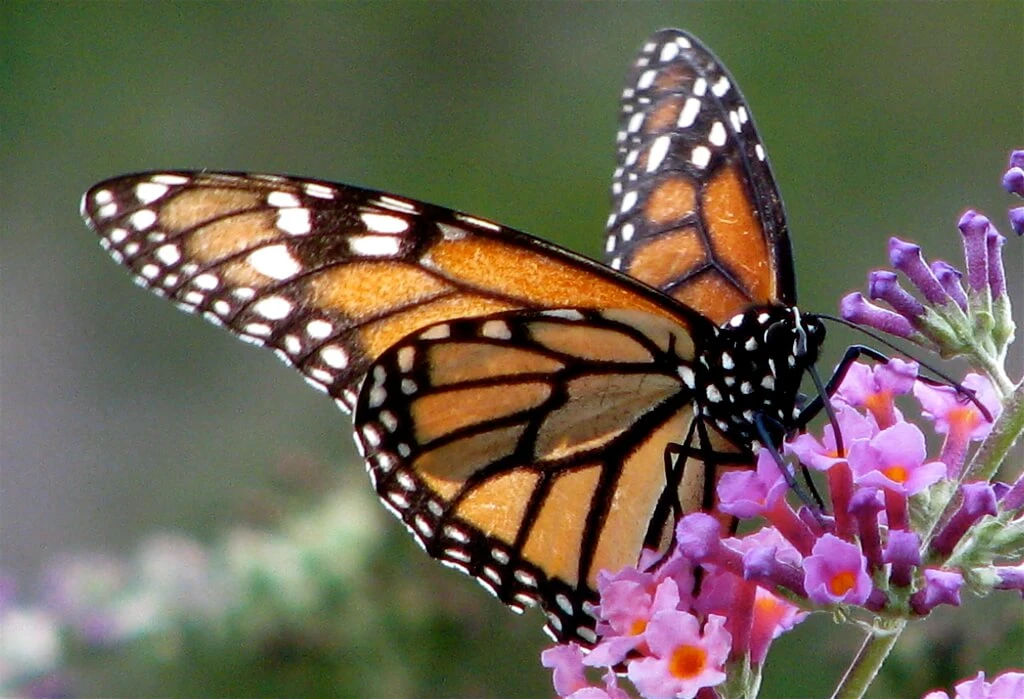
Butterflies, with their ethereal beauty and seemingly delicate nature, are often surrounded by myths and tales. Some of these myths have persisted for years, causing misconceptions about their diets and behaviors. Let’s set the record straight.
Myth 1: Butterflies only drink nectar: While it’s true that nectar is a major part of many adult butterflies’ diets, it’s not their only source of sustenance. As we’ve explored, they also seek out salts, amino acids, and other nutrients from various sources, including animal carcasses, overripe fruits, dung, sweat, and even tears.
Myth 2: Butterflies only live for a day: The lifespan of a butterfly varies by species. While some may live only a week, others can survive several months, especially if they belong to species that migrate long distances. But there are few butterflies that live only for 24 hours.
Myth 3: Butterflies eating meat is a bad sign: When we hear of butterflies seeking nutrients from meat, it might sound alarming. But it’s a natural behavior. It doesn’t mean the environment is lacking or that something is wrong. It’s merely a testament to the adaptability and resourcefulness of these insects.
Unraveling these myths helps us appreciate the complexity and resilience of butterflies even more. They aren’t just pretty creatures to look at; they’re survivors, adaptors, and a vital part of our ecosystem.
Conclusion: Embracing the Diversity of Nature
In our journey together, we’ve ventured beyond the image of a butterfly delicately perched on a flower. We’ve uncovered a world where these creatures, while delicate in appearance, are resilient, adaptable, and surprising in their habits.
Nature, in all its vastness, constantly surprises us. The dietary quirks of butterflies serve as a testament to this. From sipping nectar to seeking out salts in the most unexpected places, butterflies remind us that survival and adaptation often lead to paths less traveled.
Whether it’s a butterfly drinking from a puddle, extracting salt from an animal carcass, or engaging in the gentle act of lachryphagy, there’s a lesson in every flutter and every sip. Life is diverse, nature is ingenious, and every creature, big or small, has its unique way of navigating the challenges of existence.
So, the next time you see a butterfly, remember: behind those colorful wings lies a world of intrigue, survival, and a diet that goes way beyond the flowers.




